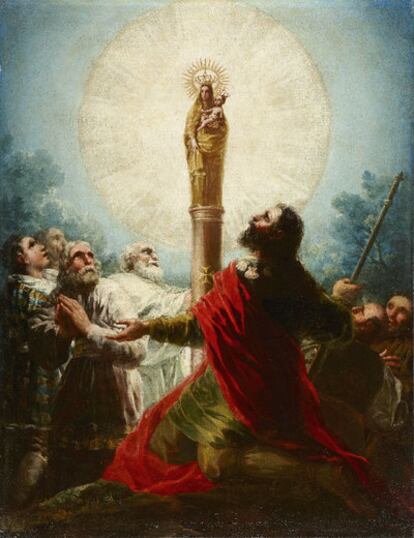Virtually unseen Goya to get a Dutch airing
Latest surprise by the Aragonese master is a painting of Saint James
The world of art attribution and authentication is as fascinating as it is unstable. Take the case of Rembrandt, for instance: his catalogue reached 600 recognized artworks in 1908, but was whittled down to 45 by 1923 before rising again to around 100, where it stands at the present time.
Goya, whose definitive catalogue is still pending despite being constantly demanded by art experts, remains an open case filled with surprises. Following the disattribution of The Colossus and the controversial attribution of La Piedad, the upcoming edition of the Maastricht Antiques Fair, to be held from March 18 to 27, will show the world El apóstol Santiago y sus discípulos adorando a la Virgen del Pilar (or, The Apostle Saint James and his disciples worshipping Our Lady of the Pillar), which Goya painted in his youth and which had until now remained off limits to the public, kept in the private salons of the Rosillo Foundation.
The 107x80cm oil, painted between 1775 and 1780, will be displayed at the stand of the Madrid antique store Caylus, which has hung a price tag of 4.5 million euros on it. The occasion will serve to show the painting off to international experts who frequent the Dutch fair, and to woo potential buyers - who must necessarily be Spanish nationals due to laws that prohibit the artwork from being exported. The state also reserves the right to repeal a sale.
It is thought that the young Goya might have painted this piece for the Pilar basilica. It depicts Saint James praying with his disciples on the banks of the Ebro river, next to the city walls of Zaragoza, at the time of Mary's apparition. The color and composition are reminiscent of those he used in another painting for one of the altars at the church of San Francisco el Grande, titled La predicación de san Bernardino de Siena (or, The preachings of Saint Bernardine of Siena), painted between 1781 and 1783.
In the documentary research on the painting, conducted by Estudios del Marqués de Lozoya y Gaudiol, it says that the first known image by Goya representing Our Lady of the Pillar is a pencil drawing on one of the pages of his "Italian notebook", which he produced around 1770 and that served as the starting point for a small painting on the same subject matter, now owned by the Museum of Zaragoza. Goya depicted the tiny Mary sculpture that presides the Basilica of El Pilar in great detail, and that same image is reproduced in the oil about to be unveiled in the Netherlands, though on a much larger scale and with a much more complex composition.
José Antonio Urbina, owner of Caylus, explains that the oil painting is in perfect condition and that nothing more than a small cleaning operation was necessary. "The fact that it did not constantly change places and hands was significant in this respect," he said. Regarding sales expectations, he admits that the painting lacks a definitive export license, and is traveling on a provisional permit. Urbina would not comment on possible buyers, although they will in all certainty be Spanish collectors, either public or private.

Tu suscripción se está usando en otro dispositivo
¿Quieres añadir otro usuario a tu suscripción?
Si continúas leyendo en este dispositivo, no se podrá leer en el otro.
FlechaTu suscripción se está usando en otro dispositivo y solo puedes acceder a EL PAÍS desde un dispositivo a la vez.
Si quieres compartir tu cuenta, cambia tu suscripción a la modalidad Premium, así podrás añadir otro usuario. Cada uno accederá con su propia cuenta de email, lo que os permitirá personalizar vuestra experiencia en EL PAÍS.
¿Tienes una suscripción de empresa? Accede aquí para contratar más cuentas.
En el caso de no saber quién está usando tu cuenta, te recomendamos cambiar tu contraseña aquí.
Si decides continuar compartiendo tu cuenta, este mensaje se mostrará en tu dispositivo y en el de la otra persona que está usando tu cuenta de forma indefinida, afectando a tu experiencia de lectura. Puedes consultar aquí los términos y condiciones de la suscripción digital.
Últimas noticias
How Japan is trying to avert ‘digital defeat’
From digital curfews to blocking apps: How technology experts protect their children online
Why the price of coffee has skyrocketed: from Brazilian plantations to specialty coffee houses
Confined to a Cuban hospital: When electricity is a matter of life or death
Most viewed
- Pablo Escobar’s hippos: A serious environmental problem, 40 years on
- Reinhard Genzel, Nobel laureate in physics: ‘One-minute videos will never give you the truth’
- Why we lost the habit of sleeping in two segments and how that changed our sense of time
- Charles Dubouloz, mountaineering star, retires at 36 with a farewell tour inspired by Walter Bonatti
- The Florida Keys tourist paradise is besieged by immigration agents: ‘We’ve never seen anything like this’








































